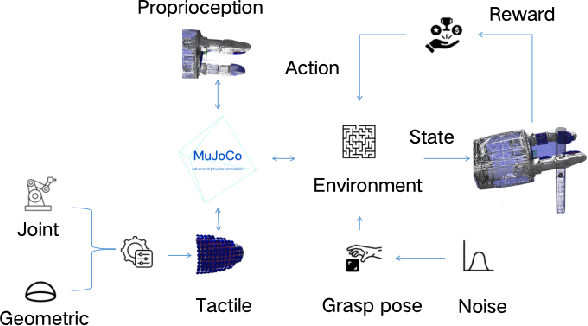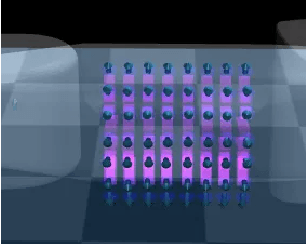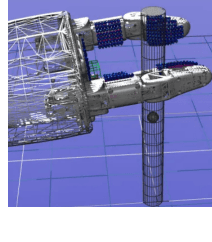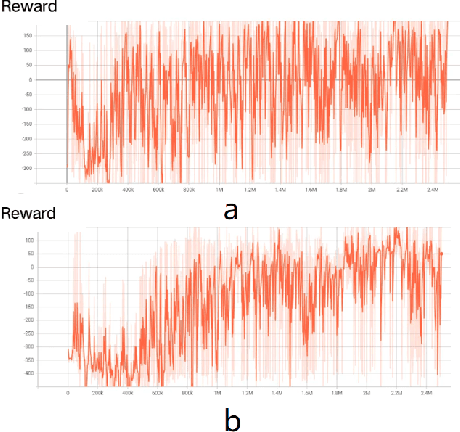Xiao Hu
Embodied Arena: A Comprehensive, Unified, and Evolving Evaluation Platform for Embodied AI
Sep 18, 2025Abstract:Embodied AI development significantly lags behind large foundation models due to three critical challenges: (1) lack of systematic understanding of core capabilities needed for Embodied AI, making research lack clear objectives; (2) absence of unified and standardized evaluation systems, rendering cross-benchmark evaluation infeasible; and (3) underdeveloped automated and scalable acquisition methods for embodied data, creating critical bottlenecks for model scaling. To address these obstacles, we present Embodied Arena, a comprehensive, unified, and evolving evaluation platform for Embodied AI. Our platform establishes a systematic embodied capability taxonomy spanning three levels (perception, reasoning, task execution), seven core capabilities, and 25 fine-grained dimensions, enabling unified evaluation with systematic research objectives. We introduce a standardized evaluation system built upon unified infrastructure supporting flexible integration of 22 diverse benchmarks across three domains (2D/3D Embodied Q&A, Navigation, Task Planning) and 30+ advanced models from 20+ worldwide institutes. Additionally, we develop a novel LLM-driven automated generation pipeline ensuring scalable embodied evaluation data with continuous evolution for diversity and comprehensiveness. Embodied Arena publishes three real-time leaderboards (Embodied Q&A, Navigation, Task Planning) with dual perspectives (benchmark view and capability view), providing comprehensive overviews of advanced model capabilities. Especially, we present nine findings summarized from the evaluation results on the leaderboards of Embodied Arena. This helps to establish clear research veins and pinpoint critical research problems, thereby driving forward progress in the field of Embodied AI.
Learning ECG Representations via Poly-Window Contrastive Learning
Aug 21, 2025Abstract:Electrocardiogram (ECG) analysis is foundational for cardiovascular disease diagnosis, yet the performance of deep learning models is often constrained by limited access to annotated data. Self-supervised contrastive learning has emerged as a powerful approach for learning robust ECG representations from unlabeled signals. However, most existing methods generate only pairwise augmented views and fail to leverage the rich temporal structure of ECG recordings. In this work, we present a poly-window contrastive learning framework. We extract multiple temporal windows from each ECG instance to construct positive pairs and maximize their agreement via statistics. Inspired by the principle of slow feature analysis, our approach explicitly encourages the model to learn temporally invariant and physiologically meaningful features that persist across time. We validate our approach through extensive experiments and ablation studies on the PTB-XL dataset. Our results demonstrate that poly-window contrastive learning consistently outperforms conventional two-view methods in multi-label superclass classification, achieving higher AUROC (0.891 vs. 0.888) and F1 scores (0.680 vs. 0.679) while requiring up to four times fewer pre-training epochs (32 vs. 128) and 14.8% in total wall clock pre-training time reduction. Despite processing multiple windows per sample, we achieve a significant reduction in the number of training epochs and total computation time, making our method practical for training foundational models. Through extensive ablations, we identify optimal design choices and demonstrate robustness across various hyperparameters. These findings establish poly-window contrastive learning as a highly efficient and scalable paradigm for automated ECG analysis and provide a promising general framework for self-supervised representation learning in biomedical time-series data.
The Maximum Coverage Model and Recommendation System for UAV Vertiports Location Planning
Aug 18, 2025Abstract:As urban aerial mobility (UAM) infrastructure development accelerates globally, cities like Shenzhen are planning large-scale vertiport networks (e.g., 1,200+ facilities by 2026). Existing planning frameworks remain inadequate for this complexity due to historical limitations in data granularity and real-world applicability. This paper addresses these gaps by first proposing the Capacitated Dynamic Maximum Covering Location Problem (CDMCLP), a novel optimization framework that simultaneously models urban-scale spatial-temporal demand, heterogeneous user behaviors, and infrastructure capacity constraints. Building on this foundation, we introduce an Integrated Planning Recommendation System that combines CDMCLP with socio-economic factors and dynamic clustering initialization. This system leverages adaptive parameter tuning based on empirical user behavior to generate practical planning solutions. Validation in a Chinese center city demonstrates the effectiveness of the new optimization framework and recommendation system. Under the evaluation and optimization of CDMCLP, the quantitative performance of traditional location methods are exposed and can be improved by 38\%--52\%, while the recommendation system shows user-friendliness and the effective integration of complex elements. By integrating mathematical rigor with practical implementation considerations, this hybrid approach bridges the gap between theoretical location modeling and real-world UAM infrastructure planning, offering municipalities a pragmatic tool for vertiport network design.
KERAP: A Knowledge-Enhanced Reasoning Approach for Accurate Zero-shot Diagnosis Prediction Using Multi-agent LLMs
Jul 03, 2025



Abstract:Medical diagnosis prediction plays a critical role in disease detection and personalized healthcare. While machine learning (ML) models have been widely adopted for this task, their reliance on supervised training limits their ability to generalize to unseen cases, particularly given the high cost of acquiring large, labeled datasets. Large language models (LLMs) have shown promise in leveraging language abilities and biomedical knowledge for diagnosis prediction. However, they often suffer from hallucinations, lack structured medical reasoning, and produce useless outputs. To address these challenges, we propose KERAP, a knowledge graph (KG)-enhanced reasoning approach that improves LLM-based diagnosis prediction through a multi-agent architecture. Our framework consists of a linkage agent for attribute mapping, a retrieval agent for structured knowledge extraction, and a prediction agent that iteratively refines diagnosis predictions. Experimental results demonstrate that KERAP enhances diagnostic reliability efficiently, offering a scalable and interpretable solution for zero-shot medical diagnosis prediction.
Kwai Keye-VL Technical Report
Jul 02, 2025Abstract:While Multimodal Large Language Models (MLLMs) demonstrate remarkable capabilities on static images, they often fall short in comprehending dynamic, information-dense short-form videos, a dominant medium in today's digital landscape. To bridge this gap, we introduce \textbf{Kwai Keye-VL}, an 8-billion-parameter multimodal foundation model engineered for leading-edge performance in short-video understanding while maintaining robust general-purpose vision-language abilities. The development of Keye-VL rests on two core pillars: a massive, high-quality dataset exceeding 600 billion tokens with a strong emphasis on video, and an innovative training recipe. This recipe features a four-stage pre-training process for solid vision-language alignment, followed by a meticulous two-phase post-training process. The first post-training stage enhances foundational capabilities like instruction following, while the second phase focuses on stimulating advanced reasoning. In this second phase, a key innovation is our five-mode ``cold-start'' data mixture, which includes ``thinking'', ``non-thinking'', ``auto-think'', ``think with image'', and high-quality video data. This mixture teaches the model to decide when and how to reason. Subsequent reinforcement learning (RL) and alignment steps further enhance these reasoning capabilities and correct abnormal model behaviors, such as repetitive outputs. To validate our approach, we conduct extensive evaluations, showing that Keye-VL achieves state-of-the-art results on public video benchmarks and remains highly competitive on general image-based tasks (Figure 1). Furthermore, we develop and release the \textbf{KC-MMBench}, a new benchmark tailored for real-world short-video scenarios, where Keye-VL shows a significant advantage.
Large Language Models for Controllable Multi-property Multi-objective Molecule Optimization
May 29, 2025Abstract:In real-world drug design, molecule optimization requires selectively improving multiple molecular properties up to pharmaceutically relevant levels, while maintaining others that already meet such criteria. However, existing computational approaches and instruction-tuned LLMs fail to capture such nuanced property-specific objectives, limiting their practical applicability. To address this, we introduce C-MuMOInstruct, the first instruction-tuning dataset focused on multi-property optimization with explicit, property-specific objectives. Leveraging C-MuMOInstruct, we develop GeLLMO-Cs, a series of instruction-tuned LLMs that can perform targeted property-specific optimization. Our experiments across 5 in-distribution and 5 out-of-distribution tasks show that GeLLMO-Cs consistently outperform strong baselines, achieving up to 126% higher success rate. Notably, GeLLMO-Cs exhibit impressive 0-shot generalization to novel optimization tasks and unseen instructions. This offers a step toward a foundational LLM to support realistic, diverse optimizations with property-specific objectives. C-MuMOInstruct and code are accessible through https://github.com/ninglab/GeLLMO-C.
Why Distillation can Outperform Zero-RL: The Role of Flexible Reasoning
May 27, 2025Abstract:Reinforcement learning (RL) has played an important role in improving the reasoning ability of large language models (LLMs). Some studies apply RL directly to \textit{smaller} base models (known as zero-RL) and also achieve notable progress. However, in this paper, we show that using only 920 examples, a simple distillation method based on the base model can clearly outperform zero-RL, which typically requires much more data and computational cost. By analyzing the token frequency in model outputs, we find that the distilled model shows more flexible reasoning. It uses anthropomorphic tokens and logical connectors much more often than the zero-RL model. Further analysis reveals that distillation enhances the presence of two advanced cognitive behaviors: Multi-Perspective Thinking or Attempting and Metacognitive Awareness. Frequent occurrences of these two advanced cognitive behaviors give rise to flexible reasoning, which is essential for solving complex reasoning problems, while zero-RL fails to significantly boost the frequency of these behaviors.
Tactile-based Reinforcement Learning for Adaptive Grasping under Observation Uncertainties
May 22, 2025



Abstract:Robotic manipulation in industrial scenarios such as construction commonly faces uncertain observations in which the state of the manipulating object may not be accurately captured due to occlusions and partial observables. For example, object status estimation during pipe assembly, rebar installation, and electrical installation can be impacted by observation errors. Traditional vision-based grasping methods often struggle to ensure robust stability and adaptability. To address this challenge, this paper proposes a tactile simulator that enables a tactile-based adaptive grasping method to enhance grasping robustness. This approach leverages tactile feedback combined with the Proximal Policy Optimization (PPO) reinforcement learning algorithm to dynamically adjust the grasping posture, allowing adaptation to varying grasping conditions under inaccurate object state estimations. Simulation results demonstrate that the proposed method effectively adapts grasping postures, thereby improving the success rate and stability of grasping tasks.
Offline Guarded Safe Reinforcement Learning for Medical Treatment Optimization Strategies
May 22, 2025Abstract:When applying offline reinforcement learning (RL) in healthcare scenarios, the out-of-distribution (OOD) issues pose significant risks, as inappropriate generalization beyond clinical expertise can result in potentially harmful recommendations. While existing methods like conservative Q-learning (CQL) attempt to address the OOD issue, their effectiveness is limited by only constraining action selection by suppressing uncertain actions. This action-only regularization imitates clinician actions that prioritize short-term rewards, but it fails to regulate downstream state trajectories, thereby limiting the discovery of improved long-term treatment strategies. To safely improve policy beyond clinician recommendations while ensuring that state-action trajectories remain in-distribution, we propose \textit{Offline Guarded Safe Reinforcement Learning} ($\mathsf{OGSRL}$), a theoretically grounded model-based offline RL framework. $\mathsf{OGSRL}$ introduces a novel dual constraint mechanism for improving policy with reliability and safety. First, the OOD guardian is established to specify clinically validated regions for safe policy exploration. By constraining optimization within these regions, it enables the reliable exploration of treatment strategies that outperform clinician behavior by leveraging the full patient state history, without drifting into unsupported state-action trajectories. Second, we introduce a safety cost constraint that encodes medical knowledge about physiological safety boundaries, providing domain-specific safeguards even in areas where training data might contain potentially unsafe interventions. Notably, we provide theoretical guarantees on safety and near-optimality: policies that satisfy these constraints remain in safe and reliable regions and achieve performance close to the best possible policy supported by the data.
R1-Reward: Training Multimodal Reward Model Through Stable Reinforcement Learning
May 05, 2025Abstract:Multimodal Reward Models (MRMs) play a crucial role in enhancing the performance of Multimodal Large Language Models (MLLMs). While recent advancements have primarily focused on improving the model structure and training data of MRMs, there has been limited exploration into the effectiveness of long-term reasoning capabilities for reward modeling and how to activate these capabilities in MRMs. In this paper, we explore how Reinforcement Learning (RL) can be used to improve reward modeling. Specifically, we reformulate the reward modeling problem as a rule-based RL task. However, we observe that directly applying existing RL algorithms, such as Reinforce++, to reward modeling often leads to training instability or even collapse due to the inherent limitations of these algorithms. To address this issue, we propose the StableReinforce algorithm, which refines the training loss, advantage estimation strategy, and reward design of existing RL methods. These refinements result in more stable training dynamics and superior performance. To facilitate MRM training, we collect 200K preference data from diverse datasets. Our reward model, R1-Reward, trained using the StableReinforce algorithm on this dataset, significantly improves performance on multimodal reward modeling benchmarks. Compared to previous SOTA models, R1-Reward achieves a $8.4\%$ improvement on the VL Reward-Bench and a $14.3\%$ improvement on the Multimodal Reward Bench. Moreover, with more inference compute, R1-Reward's performance is further enhanced, highlighting the potential of RL algorithms in optimizing MRMs.
 Add to Chrome
Add to Chrome Add to Firefox
Add to Firefox Add to Edge
Add to Edge